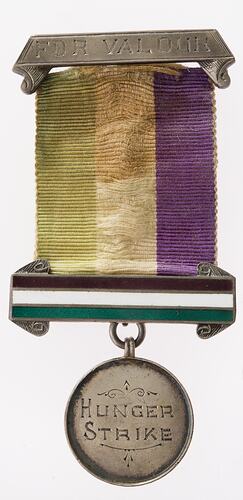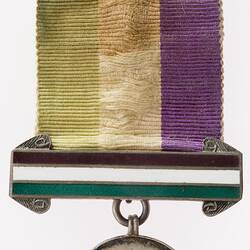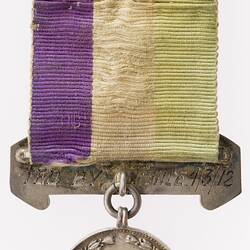Summary
Myra Sadd Brown was a women's rights activist and internationalist. She was active in the women's suffrage movement in London and became a member of the militant Women's Social and Political Union (WSPU). After breaking a window at the government's War Office in 1912, Myra was sentenced to two months in prison with hard labour. In prison, Myra joined other suffragettes in a hunger strike. The government responded by having the women restrained and force-fed. Following her release Myra was awarded a Hunger Strike Medal by the WSPU.
Early Life
Myra Sadd Brown (nee Myra Sadd) was a women's rights activist and internationalist. She was born on the 3rd of October 1872 in Maldon, Essex into a family who were noted for their innovative business ideas. She was privately educated and met her husband Ernest Brown (1868-1931) through cycling. The couple were married on 21 July 1896 with their wedding having a colour scheme of purple, white and green, which were later to become the colours of the militant Women's Social and Political Union (WSPU). Being progressive the couple combined their surnames; they had four children, three girls and one boy.
Involvement in the Women's Suffrage Movement
Myra was active in the suffrage movement before her marriage and continued her involvement following her marriage. She is even believed to have purchased a small cottage in order to claim the vote as a ratepayer. In 1902 she subscribed to the Central Society for Women's Suffrage, before joining the WSPU in 1907. She was an active member of multiple suffrage societies including the Women's Freedom League and the Free Church League for Woman Suffrage. She was a keen propagandist for the suffrage cause, her letters appearing in the Christian Commonwealth. She also involved her children in her struggle, her daughter Myra recollects being recruited to stand on street corners selling copies of Woman's Dreadnought.
Arrest & Imprisonment
On 4th March 1912 Myra was arrested for breaking a window at the British War Office. The protest resulted in substantive property damage and sixty-seven cases of window breaking went before the court. Myra's lawyer pleaded that she had been carried away by her feelings and the other women in the protest - something she was not impressed with having been very deliberate in her actions. The magistrate however couldn't understand how a women of Myra's age could be carried away by her feelings to the extent of doing wilful damage and sentenced her to two months hard labour in London's Holloway Prison, along with dozens of other suffragettes, including one of the leaders of the movement, Mrs Emmeline Pankhurst. In all, between 1905 and 1914, about 1,000 women were sent to prison protesting for political equality with men and the right to vote.
Treated by the authorities as criminals rather than political protesters, many of the women, including Sadd Brown, went on hunger strike. The government responded by having them force-fed through tubes inserted down their throats. Force feeding was a brutal and sometimes life-threatening procedure where the hunger striker was held down on a bed by wardresses or tied to a chair which they tipped back. Then a rubber tube was either forced up the nose or down the throat and into the stomach. Tissue in the nose and throat was nearly always damaged, while sometimes the tube was accidentally inserted into the windpipe, causing food to enter the lungs and endanger life. The authorities had little sympathy for the pain, humiliation and damage force feeding caused the suffragettes. On one occasion, despite informing the authorities she had a broken nose, they still insisted on attempting to force feed Myra via a nasal tube stating that 'any pain Mrs Brown may have suffered was due to her violent resistance' (Derby Daily Telegraph, 27 June 1912; Sheffield Daily Telegraph, 28 June 1912).
Myra Sadd Brown's letters to her husband capture the sense of mission and purpose that drove the suffragettes to protest for their political rights. With the prison authorities struggling to manage with the influx of suffragettes, Sadd Brown celebrated: 'I feel therefore we have begun to strike the fear of woman if not of God into the hearts of the authorities.' (6 March 1912). While on hunger strike, she wrote home 'I want you to tell all inquiring friends. that I am quite well, my spirit not in the least cooled & that I think we still have the noblest cause in the world, one well worth fighting and suffering for.' (20 April 1912).
A letter to her three children, written on toilet paper and smuggled out of the prison tells them 'I have such a funny little bed, which I can turn right up to the wall when I don't use it. I am learning French & German so you must work well or mummy will know lots more than you.' But in a serious postscript she tells her husband 'Mrs Pankhurst thinks there is enough evidence against her to give her 7 years.' (22 March 1912)
Later Life & Legacy
After the First World War Sadd Brown became an active member of the International Suffrage Alliance and was involved in meetings which led to the formation of the British Commonwealth League (later the Commonwealth Countries League) in 1925, a feminist organisation devoted to the upholding of women's rights in Commonwealth countries. Following her death in 1938 the League established the Sadd Brown Library, now part of the Women's Library. Her papers, including letters to her family from prison, are held by the Women's Library, London.
References
Crawford, Elizabeth (1999). Women's Suffrage Movement: a Reference Guide 1866-1928. Routledge, London
'Myra Sadd Brown'. (2004). Oxford Dictionary of National Biography, vol 8
Myra Sadd Brown Papers, The Women's Library, London School of Economics
'To-day's Parliament', , The Derby Daily Telegraph, Tuesday 27th June 1912
'Suffragist's Nose: A Story of Forcible Feeding', Sheffield Daily Telegraph, Friday 28th June 1912
More Information
-
Keywords
-
Localities
-
Authors
-
Article types


